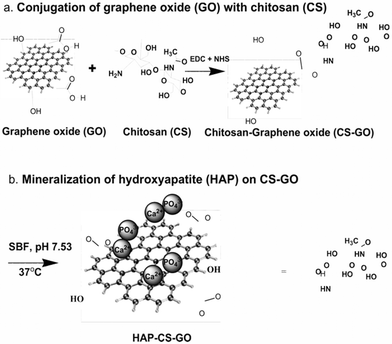
One of the primary goals within the field of hard tissue engineering is to create biomaterials that can both promote osteoblast proliferation and support the natural bone mineralization process. In this study, a trio of researchers at the University of Louisiana at Lafayette has developed a promising, layered hybrid system that contains hydroxyapatite (HAP), chitosan (CS), and graphene oxide (GO). The GO base provides mechanical strength and biocompatibility while the surface layer which is composed of HAP, a natural constituent of bone, has a high bioactivity. The intermediate chitosan layer further strengthens the hybrid biomaterial and, perhaps more importantly, has been shown to promote more homogeneous mineralization that mimics the natural biomineralization process.
In order to test the bone forming capabilities of this hybrid material the group soaked it, along with two control materials (HAP-GO and pure GO), in simulated body fluid for three weeks. Each substrate was then incubated with MC3T3-E1 pre-osteoblast cells. Among the three biomaterials, the HAP-CS-GO hybrid produced the highest levels of cell proliferation and expansion. It also induced the greatest expression levels of vinculin, actin, and fibronectin, proteins that are essential for cell adhesion, cytoskeletal organization, and osteoblast morphogenesis and mineralization. The hybrid material also demonstrated a highly significant increase in mineralized area and bone nodule formation compared to either of the two controls. This was primarily attributed to the strong electrostatic interactions between the functional groups in the CS-GO base and the calcium ions present in solution.
Overall the hybrid HAP-CS-GO material was able to favorably modulate cellular activity in a way that was conducive to bone formation, making it a promising candidate for future bone tissue engineering applications. However, as the authors have highlighted, there is room for improvement. A reoccurring issue that many bone tissue engineering materials, including this novel hybrid material, have faced is an inability to attain the proper ratio of mineral deposit to cellular matrix in the regenerated tissue. This mineral to matrix ratio has been shown to be relatively high in healthy, intact bone (~4.35-5) but was observed in a significantly lower amount (1.76) in the HAP-CS-GO material. Nonetheless, the hybrid biomaterial reported in this study represents a promising direction forward in the field of bone tissue engineering.
The synergistic effect of a hybrid graphene oxide-chitosan system and biomimetic mineralization on osteoblast functions
D. Depan, T. C. Pesacreta and R. D. K. Misra
Biomater. Sci., 2014, 2, 264-274 DOI: 10.1039/C3BM60192G
Ellen Tworkoski is a guest web-writer for Biomaterials Science. She is currently a graduate student in the biomedical engineering department at Northwestern University (Evanston, IL, USA).
Follow the latest journal news on Twitter @BioMaterSci or go to our Facebook page.
To keep up-to-date with all the latest research, sign-up to our RSS feed or Table of contents alert.










